 SHELF EXPRESSION
SHELF EXPRESSION
Physical books’ bright future — as decorative objects and props.
Set aside any emotional attachment you may feel toward the reading of physical books; the truth is that creative uses for books that do not involve engaging with words on a page already abound.
Read the column in the August 8, 2010, New York Times Magazine, or here.
Discuss, make fun of, or praise this column to the skies at the Consumed Facebook page.
Yes, this column is the culmination of my long-running musings on this subject, here and here.
Posted Under:
Consumed
This post was written by Rob Walker on August 8, 2010
Comments Off on In The New York Times Magazine: Books, the idea
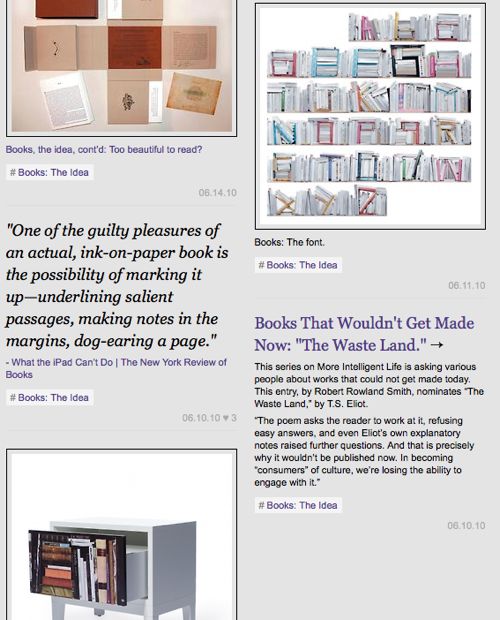
Click to continue the series in its new home.
Back in April I posted a couple of items about a fantastic 1995 Nicholson Baker New Yorker piece about books used as props in catalogs. And on April 23 I promised “one more post” on the subject, “next week.” I forgot to do so — and not one of you reminded me! Sheesh. No wonder this series has moved.
Anyway I found the draft of that “lost post” this weekend, quickly updated and finished it, and here it is:
This site’s occasional series on the idea of the book has included several instances of things (a necklace, a ring, etc.) made to look like books. That 1995 Baker piece, as it happens, mentioned similar stuff from back then:
Not only is the book the prop of commonest resort in the world of mail order, but objects that resemble books – non-book items that carry bookishly antiquarian detailing – are suddenly popular…. Catalogues now offer book-patterned ties, book brooches, and settes covered in tromp-l’oiel-bookshelf fabric.
He gives other examples: a table whose base is “a fake stack” of leather-bound books, a “book-shaped box of candy bars,” book coasters, a magnifying glass with “faux bookspine handle,” and even a “Faux Book Cassette Holder,” to disguise the evidence of your middlebrow listening habits with a suggestion of more respectable reading ones.
On an aesthetic note, Baker suggests all this leather-bound book signifying might be replaced, or at least complemented, with visual suggestions of Penguin paperbacks and the like: “Our working notion of what books look like is on the verge of becoming frozen in a brownish fantasy phase that may estrange us from, and therefore weaken our resolve to read, the books we actually own.”
A fascinating point, probably even more salient now that the proposition of ebooks squeezing away physical ones is so widely discussed. Many argue that such judgments are premature — but surely there’s a good case to be made that our idea of what a physical book is may well cease to evolve soon, if it hasn’t already.
Anyway, this series is continuing, but not here. Please visit http://murketing.tumblr.com to follow along, if you like.
Posted Under:
The Designed Life
This post was written by Rob Walker on June 28, 2010
Comments Off on Books: The Idea: Not here anymore!
In general, the series Books: The Idea is currently migrating over to MKTG. But here’s one last entry on this site.
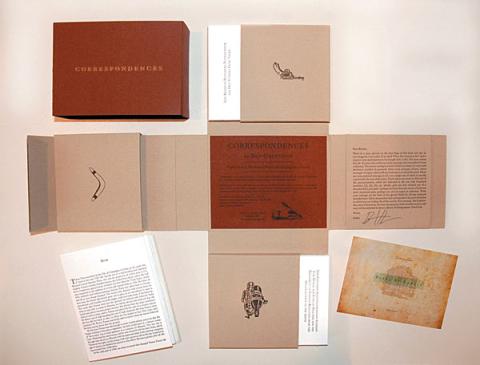
Correspondences. Click for more.
Ben Greenman’s book Correspondences, published last year, was described like so by its publisher:
Each hand-crafted, signed copy is composed of an unfolding chip-board casing built by letter-press maven Brandon Mise, which contains pockets for three accordion books bearing two stories each. The seventh story, which is written by Mr. Greenman with intentional gaps in the narrative, is printed on the casing and does something unprecedented: It invites the reader to contribute to the collection.The fourth pocket in the casing contains a postcard that the reader can use to fill in the gaps in Greenman’s narrative and send to Hotel St. George Press for possible publication in future online and paperback editions of the book.
Now that’s a book in the form of a beautiful object! Not surprisingly, it cost $50. Time Out Chicago said: “As an object, Correspondences is a genius invention. But as a book, it works just as well.”
Note the two distinct categories: “as an object” and “as a book.”
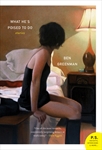 The book is about to be published again, under the title What He’s Poised To Do, and in the form of, well, of a traditional collection-of-words object. (On a not-unrelated note, Mr. Greenman, a three-time contributor to Significant Objects, has guest-curated a week of objects and epistolary stories for us over on that site, starting today.)
The book is about to be published again, under the title What He’s Poised To Do, and in the form of, well, of a traditional collection-of-words object. (On a not-unrelated note, Mr. Greenman, a three-time contributor to Significant Objects, has guest-curated a week of objects and epistolary stories for us over on that site, starting today.)
It seems that one reaction to the original version was that at it was such a great object that it was, in effect, too nice to monkey with — that is to say, it was too beautiful to read. Perhaps the new, more trad-book version will actually be more widely read. And is this not the idea of the book? To be read? Maybe, maybe not.
Personally, I’d opt for the fabulous-object version, if I had a choice.
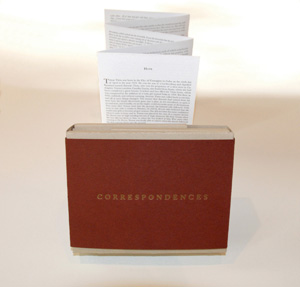
Meanwhile, as long as we’re on the subject of the super-objectified book, Gabriel Levinson recently hipped me to this: Read more
Posted Under:
The Designed Life
This post was written by Rob Walker on June 14, 2010
Comments Off on Books, the idea, cont’d: Too beautiful to read?
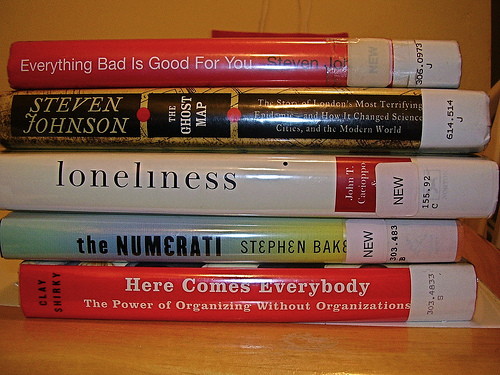
Click for more info
Friend of Murketing Gladys Santiago describes, here, her NYPL Connect project, which aims to “examine library books as catalysts to social networking. I envision this project being part real-world GoodReads, part book club. I’m interested in discovering what sort of connections can be made through communal objects.”
In noting the unique history-suggesting aspect of library books (yes, as a matter of fact, I do check books out from my walkably local library!), she’s onto something. And she’s looking to see if a connection can be made — by leaving a handwritten note in certain library books. Here’s the methodology:
I placed a handwritten note inside one of the NYPL’s 15 copies of David Shields’s Reality Hunger: A Manifesto that explains the purpose of this project and includes my contact information. I always enjoy finding things nestled between the pages of a book. I’ve found lottery tickets (all losers), a Polaroid picture, receipts, scrap paper, postcards–all evidence of life before me–and I welcome these mementos from readers past. I hope other readers do as well and are open to the possibility of connecting.
Even though I own a copy, I’m going to place a note in Clay Shirky’s Here Comes Every Body because I think this project (which for lack of a better name, I call NYPL Connect) touches on many of the concepts he discusses. A possible challenge, besides getting people to respond, might be NYPL staff or other borrowers discarding my notes before someone willing to participate reaches out to me. Regardless, I’m going to include a note in every book I check out and hope I hear from some interesting folks.
This is an awesome project! Please blog/tweet or whatever about it. And you don’t have to mention me, pretend you found it on your own, I don’t care. But she’s really onto something interesting here and the effort deserves attention. I’m dying to know if she’ll get a response to any of her notes. So cool.
This post is part of a series.
Posted Under:
"Social" studies
This post was written by Rob Walker on June 3, 2010
Comments Off on Books, the idea: Library book as connector

Former books "liberated," but still bookylikeish. Click for more.
“Are books on their way to being mere decoration?” asks the headline of this Sacramento Bee article. That of course is a running theme of this series. The article starts out by noting the item above, Antique Coverless Book Bundles, whose attraction is described by Restoration Hardware like so: “Liberated from their covers, stitched and bound with jute twine, the foxed and faded pages of old books become objêts d’art.” Books, or the suggestion of books in a book-derived object, “really do harken back to an older time,” a spokesman for the retailer tells the Bee. “These add texture to a room; they add a sense of age to the room.”
Yes, a sense of age. This is another example of the book as raw material — though in this case not for artists, but on a mass-retail scale. Anyway, the Bee writer, Gina Kim, pivots:
Is this it, the epilogue? As the Kindle, iPad and other e-readers become increasingly popular in the digital age, dog-eared books are no longer simply a tool for transporting literary works. They’ve become decoration.
Surely books have served as decoration long before the Kindle and iPad appeared, but the point is related to my interest in the way the e-book limits what I guess I’ll call the signaling function of physical books: In an e-book future, might we dream up rationales for keeping physical and displayable books around us, filling or fascinating shelves, furnishing our rooms? Kim again:
Electronic chapters and verses can’t be displayed on bookshelves. So people are turning toward companies like
Juniper Books and
Half Price Books, which sell literature by the yard with the promise that multiple copies of the same book will not be in their shipments.
“What’s interesting to me is in spite of what everyone says about the death of books, people still care to show off that they own books,” said Edward Tenner, a research affiliate at Princeton University’s Center for Arts and Cultural Policy Studies.
The best quote in the piece is this hilariously blunt assessment from a librarian in Rhode Island, describing the antecedents for display-only bookage: 19th Century mass-produced collected-works sets that added (“a sense of”) classy erudition to their owners’ homes:
You’re Joe Blow in the late 19th century America and you want a library like Lord So-And-So has but you don’t have the wherewithal to collect books and put them in their own bindings. So you buy the works of Washington Irving in sets. Did you read these books? One hopes, but generally speaking, they’re window dressing.
Posted Under:
The Designed Life
This post was written by Rob Walker on June 3, 2010
Comments Off on Books, the idea: “Mere decoration”?
You don’t have to be a technophobe or a Luddite to dismiss out of hand the idea of reading on a machine. Maybe it is muscle memory, but there is something deeply satisfying about a “real” book, a book made of pages bound between hard or soft covers, into which you can slip a bookmark, whose pages you can fan, whose binding you can crack and fold as you move from beginning to end. E-books, by contrast, whatever platform delivers them, are ephemeral. Yes, you can carry thousands of them in your pocket, but what will you have to show for it? What will fill your bookshelves?
Then, one day, you find yourself housebound, and Wolf Hall has just won the Booker Prize, and you download a sample onto your iPhone, and just like with a book printed on paper you are pulled into the story and are grateful to be able to keep reading, and your resistance disappears, and you press the “buy” button—it’s so easy!—and that is how it starts.
— Sue Halpern in the New York Review
This post part of a sporadic and increasingly incoherent series.
Posted Under:
Consumer Behavior
This post was written by Rob Walker on June 1, 2010
Comments Off on Books, the Idea: How e-appeal happens
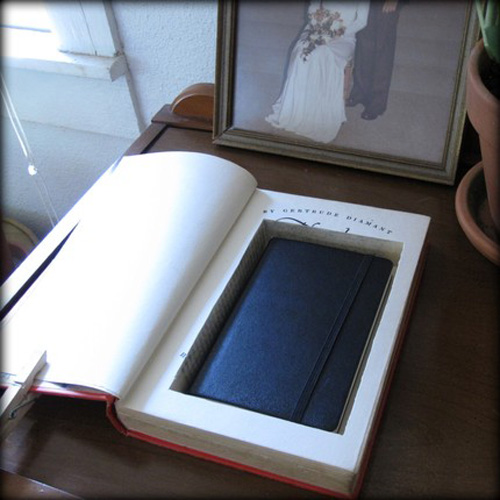
Click for more.
Moleskinerie pointed out the above item the other day. The maker is an Etsy seller, Pommes Frites. While this object is no longer available, there are other hollowed out books for sale in the Pommes Frites shop.
“This old book has been upcycled into a secret place to hide your moleskine journal!” was apparently the pitch on this one. This again goes to a recurring theme in this series: the book as raw material. You may recall the series actually began as a spinoff of a post on Significant Objects, in which I wondered allowed why that project can’t seem to get any eco-cred for upcycling with words. Maybe if we got writers to invent stories about destroyed books?
Anyway, there’s something particularly fantastic about a hollowed out book that hides, of all things, a journal. (A very special journal, to its buyers at least: See this 2005 Consumed on Moleksines).
Here are some more cool works by Pommes Frites:
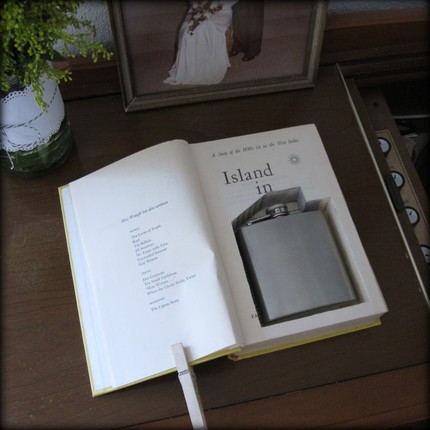
Hollow Book -- Flask. By Pommes Frites. Click for more.
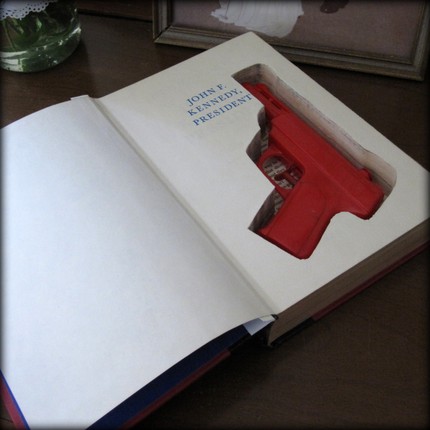
Hollow Book Pistol Safe -- SOLD. Click for more, though, it's cool.
Posted Under:
Products
This post was written by Rob Walker on May 28, 2010
Comments Off on Books, the idea, cont’d: Book for hiding a notebook, etc.
Waaaaay back in March, Elliot Van Buskirk of Wired.com posted about “Text 2.0.” A video from a Swedish technology company demonstrates what this means: Basically, eye-tracking technology monitors how you read, and the text itself reacts. Somehow it senses if you want to know how a word is defined, or pronounced, or translated, and it tells you. If it concludes that you’re just skimming, it “fades out irrelevant information” in order to “streamline your reading.”
I have zero interest in this as a reading person. I envision triangulation against databases that cross-matches my eye movements (and thus, by implication, my mind) against some “norm,” thereby sacrificing idiosyncracy and individuality to the fabled CloudCrowd yet again. I also have zero interest as a writing person. I happen to think textual communication with an engaged reader is a truly singular thing, and the idea of some tech firm’s supposed expertise monkeying around in the middle of that connection is depressing. Moreover, in both scenarios, I’m fundamentally skeptical that the real-life quality of the technology will be remotely proximate to the sales pitch. Stuff like this makes me think of a future in which some sort of Clippy equivalent informs me that I don’t actually like Milan Kundera after all.
That said, as someone compiling an occasional series on the idea of the book, I’m very interested in this concept. If something like this somehow compiled individual reader data, straight from the eyeball, it could be another layer on the stuff that Amazon is tracking and broadcasting with its “Kindle highlighting” information. People who believe they need a mass of personal-behavior data to tell them who they are might want to know which passages this tracking software has concluded they like (as opposed to which passages they thought they liked, by highlighting, or simply by, you know, thinking.) Those who like the results might then have an interest in “sharing” them — Text 2.0 could automatically tweet its conclusions (“Turns I out I don’t like Kundera”), per your settings.
As Van Buskirk notes, the appearance of something like Text 2.0 is highly plausible, as the iPad and other e-readers evolve to include cameras; his reporting indicates that many of the relevant patents and business deals already seem to be in motion. (Here’s another link to his writeup.) He also makes the case that eventually this sort of technology could “reinvigorate the written word,” basically giving ebooks a fresh way to compete in the attention economy. Maybe he’s right, and in any case he’s saying what you would probably expect a Wired.com writer to say. But he also says something you probably wouldn‘t expect: At the moment, he’s not really into ebooks:
I should admit that I have yet to make the leap to an e-reader. Having grown up a bookworm in the ’70s and ’80s, I prefer the feel and even the smell of paper books — and the fact that I can just chuck one in my bag for whenever I have a spare moment, without worrying about batteries, theft or breakage.
Probably there are rationally convincing response to these points that any e-reader enthusiast could make — surely paper-book-smell technology is in the offing!
But that’s just the thing — the idea of the book isn’t strictly a rational thing. If it were, there wouldn’t be much interesting about it, now would there?
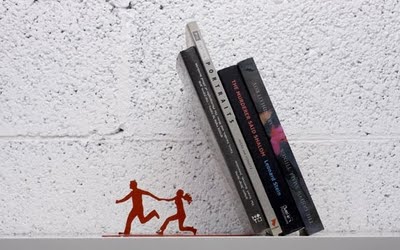
By Art Ori. Click for more.
Via Bookshelf blog. Not so practical, but interesting. Earlier bookends here. Part of a series.
Posted Under:
Products
This post was written by Rob Walker on May 12, 2010
Comments Off on Books, the idea, cont’d: Interesting end
As you may know, Amazon is now compiling and making available to the public information about the “most highlighted” books among Kindle users, and even the “most highlighted” passages. A Dan Brown book, the Bible, and a book I’ve never heard of called The Shack are the top http://pted.org/Propecia.php three most-highlighted works as I type this. In general, the books on that list are religious/spiritual titles; self-help stuff; business-advice books; or some combination of those categories. This is not exactly a surprise, but it’s interesting to see.
It’s more interesting to parse the most highlighted passages, which you can do here. Below the jump, I’ve listed the top ten passages (as of the moment when I’m typing this), without naming the authors or books. I think it’s more fun to read them without that context. And also to wonder about the people who did the highlighting. Perhaps, inspired by David Shields, someone could ativan build an essay, or even a whole book, out of these mostly platitudinous word clusters.
That’s a joke (sort of). But of course this is just the sort of techno-driven development in reading/books that has, in a sense, inspired this entire series. As many have noted:
- books are containers of readable information or stories and so on
- but also: books are display objects (on shelves, or simply being read in public)
Earlier I suggested that if books are going to migrate into digital-only form in time, then perhaps people will need a flat-screen “shelf” that displays the digital spines of whatever we’re reading — or want people to think we’re reading.
I’m not completely serious about this stuff … but I’m not completely kidding. What could be done with the information that Amazon is gathering from Kindle users? Possibly your favorite highlighted passages could be a screensaver or something? Or run a as a kind of news ticker beneath the digital renderings of bookspines or the virtual shelving unit described above?
Anyway. Here are those top highlighted passages. See what you make of them: Read more
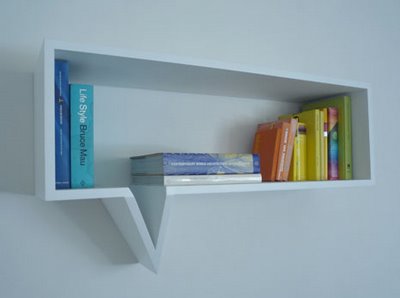
By Oscar Nuñez, click for more
“Not available for Kindle,” is the headline on a MetaFilter item: “There may be more ways to shelve your books than there are books.” It links to four posts on a site called WebUrbanist, each of which rounds up multiple examples of unusual (innovative? weird?) bookshelves or bookshelf variations or comments on the form of the form of the bookshelf.
Some examples are things that have come up in this series before, like the “curated” bookshelf, and the work of Jim Rosenau — though here’s one more image of Rosenau’s impressive work anyway:
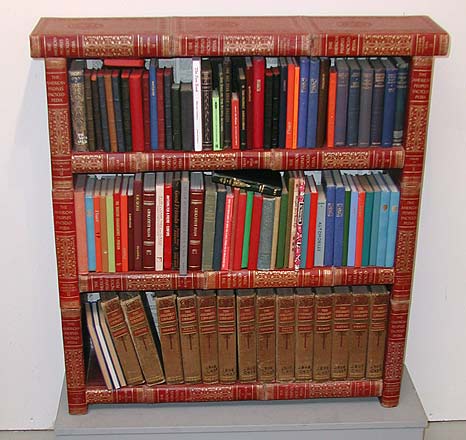
Bookshelf made of books; By Jim Rosenau; click for more.
I’ve had the passing thought in my ongoing excavation of the previously mentioned Bookshelf blog (actually the source of the top image on this post; it just seemed appropriate) that physical books are going to survive for a very long time, if for no other reason than to supply the demand for something to put on the rather astonishing number shelf solutions designers and artists seem to be dreaming up nonstop.
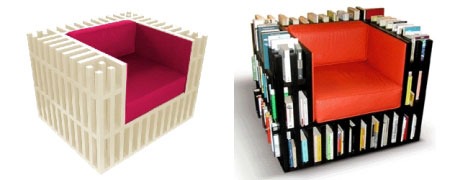
“Bibliochaise” on WebUrbanist, click for more.
DIY types, too:
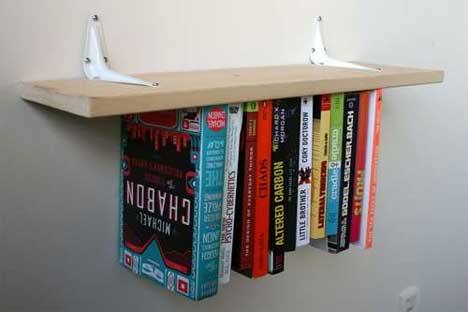
Via WebUrbanist; click for more.
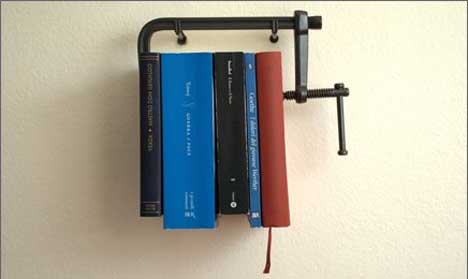
Via WebUrbanist, click for more
On the other hand, the second comment to that MeFi post counters: “Only point is, no real book lover would spend so much money on something that has so little to do with reading. Most of the cases linked are for people who buy their books by the colour of the covers.” [UPDATE: The picture below, not attributed on WebUrbanist, is by Flickr user chotda, and can be viewed (with annotations) here. (Thx Cybele).]
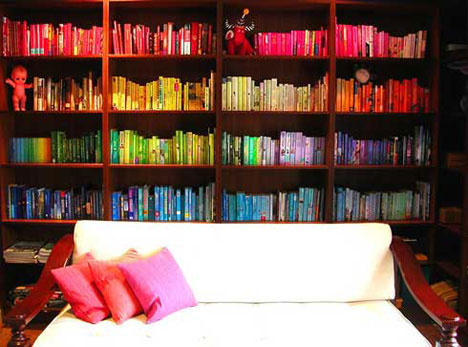
Via WebUrbanist
Ah, but on the third hand, with books and shelves on the brain I couldn’t help but be amused by this comment in a Mindhacks link roundup: “Why Humans Have Sex. A podcast for the The New York Academy of Sciences oddly fails to mention wanting to check out people’s bookshelves. Maybe that’s just me?”
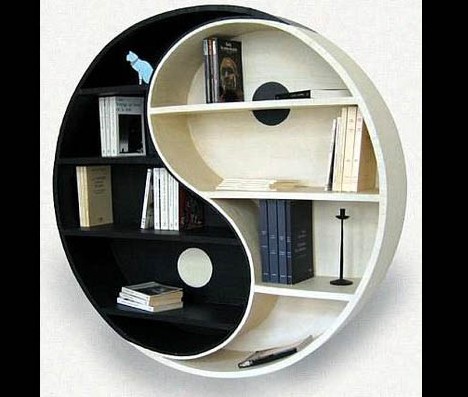
Via Web Urbanist; click for more.
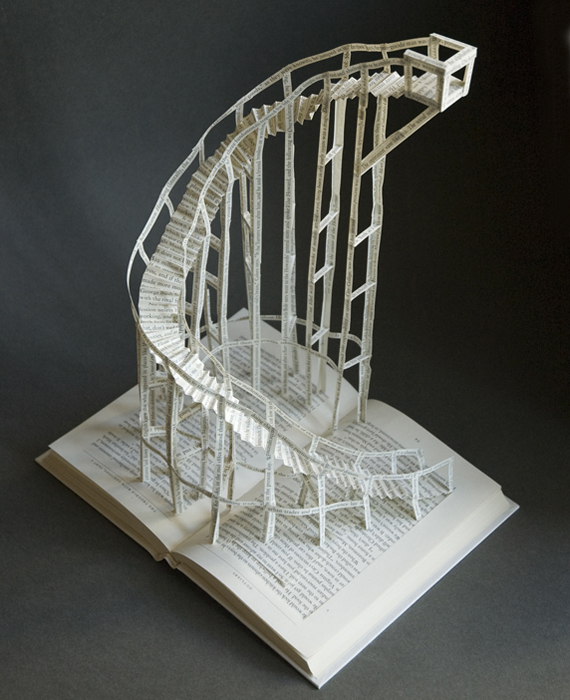
By Stephen Doyle. Click for more.
Junk Culture strikes again with this post pointing to a photo-filled interview with Stephen Doyle. Excerpt:
Q Why work with paper and books?
Books are where ideas come from. The book is such a great form. Before doing these works, I was making concrete casts of books. What interested me was, if you take all the information out, does the form still have any power?
Somewhere along the line I started wondering, well, what does happen when you take the ideas out? So, I started taking out the binding and the pages and setting the words free. And I’ve been working from there.
This post is part of a series.
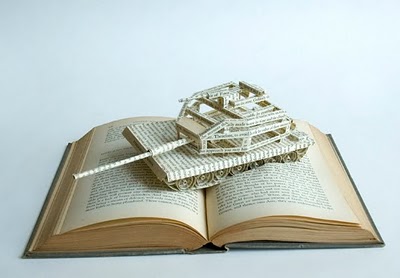
By Stephen Doyle. Click for more.
Posted Under:
Artists
This post was written by Rob Walker on May 7, 2010
Comments Off on Books, the idea: Paper sculpture
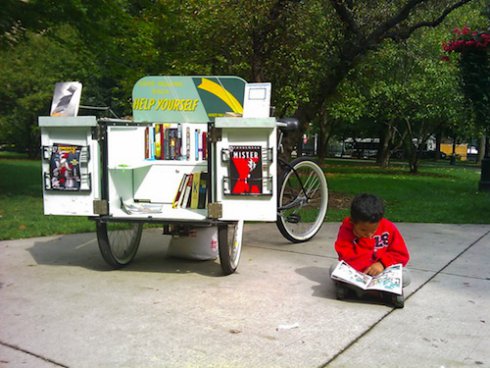
Click for more info.
Okay, this is a bit of a cheat, because it involves friend of Murketing Gabriel Levinson, but I have to throw The Book Bike into this series. And in a way, it fits perfectly. Here’s some info:
Everyone has the right to build and cherish a private library.
With this in mind, we present The Book Bike: a custom-built tricycle stocked with 200 lbs of free books. Since July of 2008, The Book Bike has been responsible for placing over 3,000 new and used books into peoples’ hands. In spring and summer, you’ll find The Book Bike at Chicago public parks on the weekends; anyone who wants a book is invited to take something home to read.
In the summer of 2010, The Book Bike puts a spotlight on independent publishers: from hand-crafted zines to literary magazines and books, The Book Bike is a unique resource of the global independent literary scene….
More here. Oh, and if you’re in Chicago and encounter the Book Bike: I’ll be donating some back issues (2008 and 2007) of my annual zine, Where Were You?
Posted Under:
Pleasing
This post was written by Rob Walker on May 6, 2010
Comments Off on Books, the idea, cont’d: The Book Bike
When I first saw these via Junk Culture, I thought it was something I’d covered previously in this series. But now I think not — I believe I was thinking of the Brian Dettmer work noted here. This is a different artist, Alexander Korzer-Robinson, making Book Objects:

"Development of the Human Heart," Click for more.
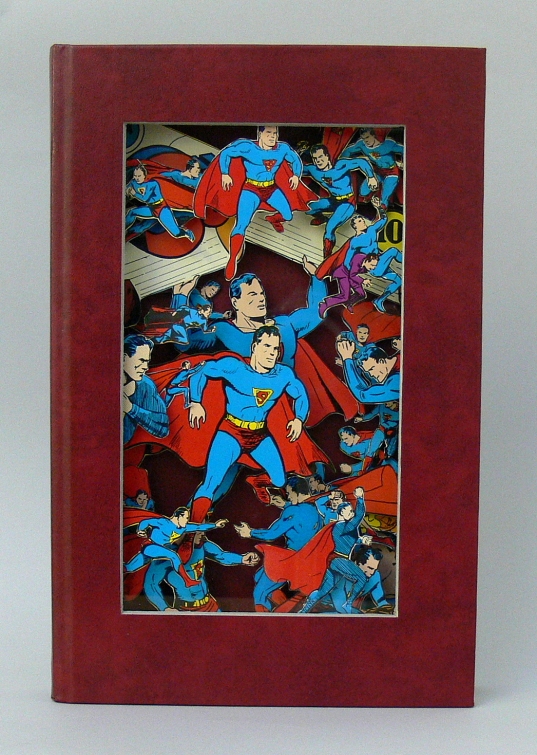
"To The Rescue," Click for more.
Posted Under:
Artists
This post was written by Rob Walker on May 6, 2010
Comments Off on Books, the idea: Sculpture-objects
While I thought a book vending machine was a strange one-off from the past, Steve Portigal sets me straight with this pic he took at Heathrow just last November:
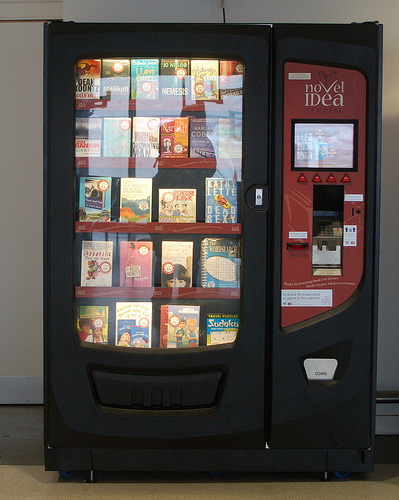
Pic by Steve Portigal, click for more.
This post is part of an occasional series.
Posted Under:
Things/Thinking
This post was written by Rob Walker on May 5, 2010
Comments Off on Books, the idea: Contemporary vending machine example
 SHELF EXPRESSION
SHELF EXPRESSION



 "
"



































 Kim Fellner's book
Kim Fellner's book  A
A